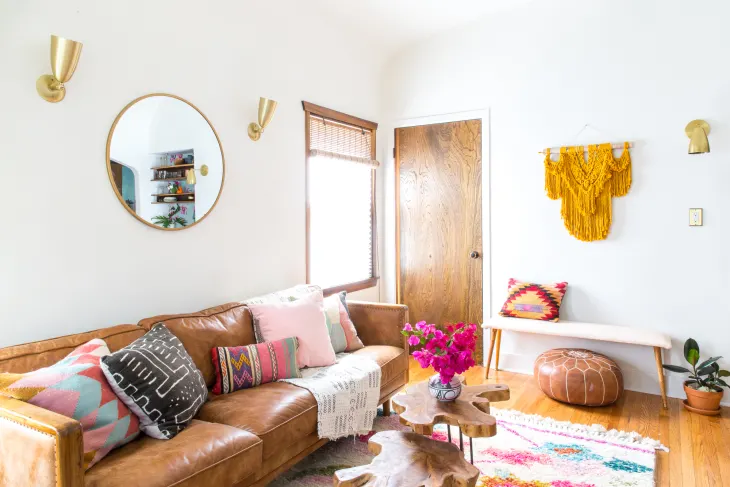Scrolling through Instagram can feel like a masterclass in want versus need. While most people covet designer handbags or exotic vacations, others find themselves fixated on something equally unattainable: luxury interior design. Those perfectly curated rooms with $200-per-yard fabrics and custom millwork can make your own space feel inadequate by comparison.
The reality behind those Instagram-worthy interiors is sobering. A single room makeover by a high-end designer can easily cost $150,000 or more. That Christopher Farr fabric draped effortlessly across a designer sofa? It’ll run you over $5,000 just for the yardage. The custom built-ins framing that perfectly styled bookshelf? Add another $20,000.

But here’s what the design world doesn’t want you to know: you can achieve that same sophisticated, magazine-ready look without the six-figure price tag. The secret lies in understanding the fundamental design principles that make expensive rooms work, then applying those same concepts using budget-friendly alternatives.
This guide will show you exactly how to decode luxury design and recreate it in your own home without breaking the bank.
Understanding What Makes Expensive Design Look Expensive
Before you can recreate high-end design, you need to understand what separates a $150,000 room from a $1,500 one. It’s not just about the price tags on individual items.
Quality of materials plays a huge role. Expensive rooms feature natural materials like solid wood, genuine leather, and high-thread-count fabrics. These materials age beautifully and have a substantial feel that cheaper alternatives often lack.
Attention to detail is another hallmark of luxury design. Custom millwork, perfectly fitted upholstery, and hardware that feels substantial all contribute to an expensive look. Even small details like the weight of drawer pulls or the precision of seam lines make a difference.
Color sophistication also sets expensive rooms apart. High-end designers often work with complex, nuanced color palettes rather than basic primary colors. They layer different tones and textures to create depth and interest.
Scale and proportion matter tremendously. Expensive rooms feature furniture and accessories that are properly sized for the space. Nothing looks cramped or oversized.
Creating Your Design Foundation Without a Designer
The first step to achieving expensive-looking design is developing a clear vision. Professional designers spend significant time researching and planning before making any purchases.
Start by creating a mood board of rooms that inspire you. Save images from Instagram, Pinterest, and design magazines. Look for common threads in your selections recurring colors, furniture styles, or architectural elements.
Next, identify the key elements that make those rooms special. Is it the rich, layered textures? The sophisticated color palette? The mix of vintage and modern pieces? Understanding what draws you to certain designs will help you make better purchasing decisions.
Develop a realistic timeline and budget. Rome wasn’t built in a day, and neither are beautiful rooms. Plan to build your space over time, investing in key pieces gradually rather than rushing to fill everything at once.
Smart Shopping Strategies for High-End Looks
Invest in statement pieces that will have the biggest visual impact. A beautiful sofa or dining table can anchor an entire room and make everything else look more expensive by association.
Mix high and low strategically. Splurge on items you’ll use frequently and that affect comfort like your mattress or office chair. Save on decorative accessories and items that don’t get heavy use.
Shop vintage and consignment for unique pieces with character. A well-made vintage piece often costs a fraction of its new equivalent while offering better quality than modern budget furniture.
Time your purchases around sales cycles. Many furniture retailers have predictable sale seasons. Shop for outdoor furniture at the end of summer, holiday decor in January, and furniture during major holiday weekends.
Consider quality secondhand options like estate sales and online marketplaces. You can often find designer pieces at a fraction of their retail cost.
Budget-Friendly Alternatives to Expensive Materials
Fabric alternatives: Instead of $200-per-yard designer fabric, look for similar patterns and colors from fabric stores or online retailers. Companies like Spoonflower offer custom printing that can mimic expensive designer patterns at a fraction of the cost.
Flooring solutions: Luxury vinyl plank can convincingly mimic hardwood or stone at a much lower cost. High-quality laminate has also improved dramatically and can look surprisingly authentic.
Paint as your secret weapon: A sophisticated paint color can instantly elevate a space. Invest in high-quality paint in complex, nuanced colors rather than basic shades from the builder-grade palette.
Hardware upgrades: Swapping out basic cabinet hardware for more substantial pieces can make kitchen and bathroom cabinets look custom. Look for hardware with weight and finish quality rather than the cheapest options.
DIY Projects That Deliver Luxury Results
Crown molding and trim work can add architectural interest and make ceilings appear higher. With some patience and the right tools, this is achievable for most DIYers.
Built-in look-alikes can be created using stock cabinets and custom trim work. This approach costs far less than true custom millwork while achieving a similar visual impact.
Window treatments make an enormous difference in how expensive a room looks. Floor-to-ceiling curtains in quality fabric can transform any space. Hang them close to the ceiling and let them puddle slightly on the floor for a luxurious look.
Custom artwork doesn’t have to come from galleries. Large-scale photography prints, framed fabric samples, or even painted canvases can create sophisticated wall art at a fraction of gallery prices.

Color and Lighting Secrets of Expensive Rooms
Luxury rooms rarely rely on overhead lighting alone. Layer different types of lighting ambient, task, and accent to create depth and warmth. Table lamps, floor lamps, and sconces all contribute to a more sophisticated lighting scheme.
Choose light bulbs with warm color temperatures (2700K-3000K) rather than cool white bulbs. This creates the cozy, inviting atmosphere found in expensive hotels and restaurants.
Paint colors in expensive rooms tend to be complex rather than basic. Instead of plain white walls, consider warm whites with subtle undertones, or rich, saturated colors that change throughout the day.
Use color strategically to create flow between rooms. A cohesive color palette throughout your home will make it feel more intentional and designed.
Styling and Arrangement Techniques from Professional Designers
The rule of threes applies to styling accessories. Group items in odd numbers for more visual interest.
Layer textures and materials to add depth. Combine smooth and rough textures, matte and glossy finishes, and hard and soft materials within the same space.
Create vignettes rather than spreading accessories randomly throughout a room. Group related items together to create intentional styling moments.
Scale accessories appropriately. One large piece of art often looks more expensive than several small pieces. The same principle applies to accessories and decorative objects.
Leave breathing room. Expensive rooms rarely look cluttered. Give your beautiful pieces space to be appreciated.
Making Your Space Instagram-Ready for Real Life
Creating a beautiful room isn’t just about copying what you see online. The most successful spaces balance aesthetics with functionality.
Consider how you actually use your space and choose furnishings accordingly. A beautiful but uncomfortable sofa won’t serve you well in the long run.
Invest in quality storage solutions to keep clutter at bay. Built-in storage doesn’t have to be custom creative use of bookcases, baskets, and furniture with hidden storage can be just as effective.
Choose a color palette you genuinely love rather than following trends. You’ll be living with these choices long after the Instagram post that inspired them has been forgotten.

Your Path to Luxury Design on Any Budget
Creating an expensive-looking home doesn’t require an expensive budget it requires patience, planning, and smart decision-making. Start with a clear vision, invest strategically in key pieces, and build your space gradually over time.
Remember that the most beautiful rooms tell a story about the people who live in them. While it’s fine to draw inspiration from social media, the best spaces reflect your personal style and meet your actual needs.
Focus on quality over quantity, mix high and low-end pieces strategically, and don’t underestimate the power of good lighting and sophisticated color choices. With these principles in mind, you can create a home that rivals any Instagram-worthy interior at a price that won’t keep you up at night.
FAQs: Frequently Asked Questions
Q1: Can I achieve a luxurious interior design look on a small budget?
Absolutely! By prioritizing key elements such as lighting, color schemes, and strategically placed décor, you can create a high-end aesthetic without overspending. Look for affordable alternatives like thrifted furniture, DIY projects, or secondhand items that add charm and uniqueness to your space.
Q2: What are some easy ways to make a room feel more expensive?
Start with good lighting layer your light sources with ambient, task, and accent lighting. Add textures such as plush rugs, throw pillows, or velvet upholstery. Incorporate metallic finishes and mirrors to reflect light and give the room a polished touch.
Q3: Do I need to hire a professional interior designer to get Instagram-worthy results?
Not necessarily. With some research and creativity, you can achieve stunning results on your own. Use social media platforms, design blogs, or magazines for inspiration, and plan your design carefully. However, for complex projects, consulting a professional might be worthwhile.
Q4: How can I choose the right color palette for my space?
Consider the mood or atmosphere you want to create. Neutral tones often feel timeless and elegant, while bold colors can add personality and energy. Use tools like color swatches and online visualizers to see how shades work together before committing.
Q5: Where can I find affordable yet stylish furniture and décor?
You can find great deals at local thrift stores, online marketplaces, and discount home stores. Additionally, look for seasonal sales or consider upcycling existing pieces to align with your design vision.
Click HERE For More.
